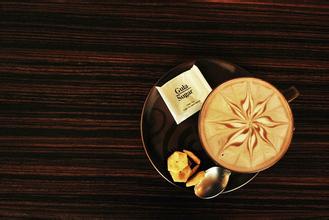Sweet and bitter Brazilian coffee bean production area planting conditions environment manor flavor description treatment taste introduction
Introduction of Brazilian Coffee Flavor description treatment
Brazil is vividly compared to the "giant" and "monarch" of the coffee world. There are about 3.97 billion coffee trees there, and small farmers now grow 75% of Brazil's total coffee production. The number of coffee producers in Brazil is twice or even three times that of Colombia, the second largest coffee producer in the world.
Unlike in the past, Brazil's economy is now less dependent on coffee, which accounts for only 8% to 10% of GDP. Before World War II, Brazil accounted for 50% or more of the world's coffee production, and now it is close to 30%. But the country's impact on the world's coffee, especially on coffee prices, is significant. For example, two frost disasters in 1994 caused a sharp rise in global coffee prices.
Since the introduction of coffee trees from French Guiana (Guyana) in 1720, coffee production has gradually become a science. Before 1990, the Brazilian government carried out strict monitoring of the coffee industry, with both strict intervention and price protection measures, and the state has been implementing minimum price protection measures for farmers, resulting in coffee overproduction. Before World War II, the surplus stock reached 78 million bags, which had to be burned by fire or thrown into the water to destroy.
Including all coffee beans grown in Brazil, except for Santos, Brazilian beans are mostly "cheap and good" coffee. Can be used for mass production of comprehensive coffee beans, most of which are re-roasted. The main raw material of instant coffee is also Brazilian coffee beans. When the coffee bean germ is very fresh, it is artificially refined and naturally dried in the vulva for about 60-70 days, so that the sweetness of the pulp fully infiltrates into the bean. Features: coffee beans have a strong aroma, moderate bitterness, high texture acidity, soft overall taste, low acidity and endless aftertaste. The taste of Brazilian coffee has a low sour taste, with the sweet and bitter taste of coffee, the entrance is very smooth, but also with a hint of grass aroma, slightly bitter in the fragrance, smooth and smooth, with a pleasant aftertaste. There are no outstanding advantages for Brazilian coffee, but there are no obvious drawbacks, such as mild and smooth taste, low acidity and moderate mellow.
In the 19th century, coffee was grown almost all over the country, followed by a "coffee boom" that lasted nearly a century. The extensive cultivation of coffee has brought wealth and prosperity to Brazil. At the beginning of the 20th century, Brazil's coffee production accounted for more than 75% of the world's total output, thus winning the laudatory name of "coffee kingdom". Coffee is one of the important pillars of Brazil's national economy. There are 500000 coffee plantations, large and small, with a planting area of about 2.2 million hectares, a working population of more than 6 million, an annual output of about 2 million tons of coffee, and an annual export earnings of nearly 2 billion US dollars. In recent years, Brazilian coffee production and exports have declined due to changes in the export structure and the downturn in the international coffee market. Brazilians love coffee. In the 1960s, per capita annual coffee consumption in Brazil reached 5.8 kg. In the past two decades, with the emergence of other drinks, the per capita coffee consumption in Brazil is still more than 3 kilograms. In Brazil, all kinds of coffee houses can be seen everywhere in both urban and rural areas. People can drink hot coffee with rich fragrance almost anytime, anywhere.

Important Notice :
前街咖啡 FrontStreet Coffee has moved to new addredd:
FrontStreet Coffee Address: 315,Donghua East Road,GuangZhou
Tel:020 38364473
- Prev

Introduction to the quality characteristics of Ethiopian Coffee Bean Story Flavor description
Ethiopian coffee beans Ethiopians drink coffee from a 3-ounce earless cup. after the coffee powder boils for the first time in a clay pot, the hostess pours the coffee into the cup and adds a spoonful of sugar. The coffee made in this way is very thick, and the coffee grounds are not filtered. Although most of them remain at the bottom of the cup, there is still powder suspended in the coffee. People who are not used to it will inevitably choke their mouths.
- Next

Guji, Ethiopia G1 washed sun-cured coffee beans flavor description treatment of variety characteristics
Ethiopian coffee flavor description introduces Ethiopia's Yirgacheffe coffee, although petite, it is gentle and delicate, sweet and lovely. As the hometown of coffee, thousands of years of planting history and processing tradition in Ethiopia have created high-quality washed Arabica beans. Light baking has a unique sweet aroma of lemon, flower and honey, with soft acidity.
Related
- Detailed explanation of Jadeite planting Land in Panamanian Jadeite Manor introduction to the grading system of Jadeite competitive bidding, Red bid, Green bid and Rose Summer
- Story of Coffee planting in Brenka region of Costa Rica Stonehenge Manor anaerobic heavy honey treatment of flavor mouth
- What's on the barrel of Blue Mountain Coffee beans?
- Can American coffee also pull flowers? How to use hot American style to pull out a good-looking pattern?
- Can you make a cold extract with coffee beans? What is the right proportion for cold-extracted coffee formula?
- Indonesian PWN Gold Mandrine Coffee Origin Features Flavor How to Chong? Mandolin coffee is American.
- A brief introduction to the flavor characteristics of Brazilian yellow bourbon coffee beans
- What is the effect of different water quality on the flavor of cold-extracted coffee? What kind of water is best for brewing coffee?
- Why do you think of Rose Summer whenever you mention Panamanian coffee?
- Introduction to the characteristics of authentic blue mountain coffee bean producing areas? What is the CIB Coffee Authority in Jamaica?

